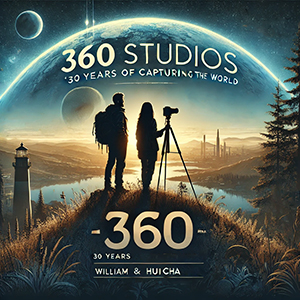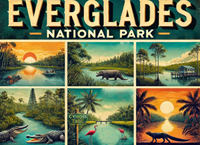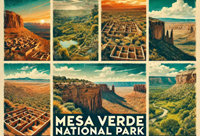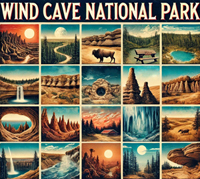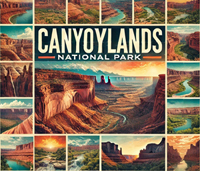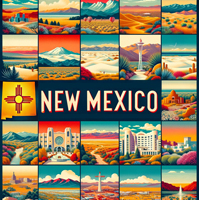

Embark on a journey curated by seasoned explorers William and Hui Cha Stanek, who have spent decades immersing themselves in the diverse landscapes of North America. These itineraries are more than just travel plans - they are thoughtfully crafted adventures designed to help you connect with the natural world, discover hidden gems, and create lasting memories.
National Parks Index | US Itineraries Index | American Roadtrips Index

Bring home a Bugville Critters book and watch as your child's love for reading and learning grows with every page. Hand-painted illustrations bring the heartwarming stories to life. Ask your librarian to add Bugville Critters to the library's digital collection today!
Discover William Stanek's Exclusive Art Collection
Explore and purchase the stunning art featured on this site. Own a piece of William Stanek's unique and captivating artwork today!
(May 13, 2025) Exploring Everglades and Big Cypress
Introduction: A 3-Day Journey Through Florida's Wetland Wilderness
The wetlands of South Florida are a place of mysterious beauty and abundant life, where the slow, meandering rivers weave through sawgrass prairies, and towering cypress trees stand as silent sentinels over the swamp. For us, William and Hui Cha, exploring the Everglades and Big Cypress National Preserve was a journey into a landscape unlike any other – a vast, untamed wilderness teeming with wildlife, from the stealthy alligators that glide through the waters to the colorful birds that fill the skies.
For Hui Cha, the Everglades and Big Cypress represented a stark contrast to the towering mountains and dense forests of other parks we had explored. The flat, expansive landscape presented new challenges and opportunities for photography, requiring a different approach to capturing the essence of this unique environment. For me, William, this trip was about immersing ourselves in the subtle beauty of the wetlands – where the lines between land and water blur, and the play of light on the water's surface creates a constantly changing canvas.
This dual adventure was about more than just capturing images; it was about experiencing the profound quiet of the swamps, the thrill of encountering wildlife in its natural habitat, and the sense of wonder that comes from exploring one of the most biodiverse ecosystems in the world. In this guide, we'll take you through our detailed itineraries, share specific tips and techniques for photographing these incredible environments, and offer alternative activities for those seeking a less strenuous experience. Whether you have just one day or a full three days to explore, this guide will help you make the most of your journey through Florida's iconic wetlands.
Day 1: Discovering the Heart of the Everglades National Park
Morning: Sunrise at Anhinga Trail
6:00 AM - Sunrise at Anhinga Trail
Overview: Begin your adventure in Everglades National Park with a sunrise visit to the Anhinga Trail, one of the park's most accessible and wildlife-rich areas. The trail is named for the Anhinga, a water bird known for its long neck and striking silhouette. As the sun rises over the sawgrass marshes, the trail comes alive with the sounds of waking wildlife – birds calling, fish splashing, and the occasional rustle of an alligator slipping into the water.
Tips from William: "Arrive at least 30 minutes before sunrise to set up your shot. Use a wide-angle lens to capture the vast expanse of the wetlands, and a tripod to ensure sharpness in the low light. The early morning light will add a warm glow to the scene, highlighting the textures of the grasses and the reflections in the water. Keep an eye out for wildlife – this is one of the best times to spot alligators, herons, and other creatures as they begin their day."
Insights from Hui Cha: "The mornings in the Everglades can be cool and filled with a serene stillness that is almost otherworldly. The Anhinga Trail is a great place to experience this tranquility while also being close to abundant wildlife. Bring a pair of binoculars to get a closer look at the birds, and dress in light layers to stay comfortable as the day warms up."
How to Access Anhinga Trail:
- Location: The Anhinga Trail is located near the Royal Palm Visitor Center, about 4 miles from the main entrance of Everglades National Park in Homestead, Florida.
- Travel Directions: From the Ernest F. Coe Visitor Center, head south on the main park road for about 4 miles until you reach the Royal Palm Visitor Center. The trailhead is located next to the visitor center.
- Trail Details: The Anhinga Trail is a 0.8-mile round-trip boardwalk trail that winds through the wetlands. The trail is flat and accessible, making it suitable for visitors of all ages and abilities.
Alternative Activity: Pa-hay-okee Overlook
- For a different sunrise experience, consider visiting the Pa-hay-okee Overlook, located about 12 miles south of the Royal Palm Visitor Center. The overlook offers sweeping views of the Everglades' vast sawgrass prairie, and the elevated boardwalk provides a great vantage point for photography.
Photographic Techniques:
- Golden Hour Lighting: The soft, golden light of sunrise will enhance the warm tones of the wetlands. Use this light to highlight the textures of the sawgrass and the reflections in the water, creating a sense of depth in your images.
- Wide-Angle Shots: Use a wide-angle lens to capture the full scope of the landscape, including the marshes, the wildlife, and the expansive sky. The interplay of light and shadow at sunrise can create stunning compositions.
- Wildlife Photography: Keep your telephoto lens ready to capture close-up shots of wildlife. Early morning is an ideal time to spot birds and alligators along the trail.
Exploring the Area:
- After photographing the sunrise at the Anhinga Trail, consider exploring other nearby trails, such as the Gumbo Limbo Trail, which offers a shaded walk through a tropical hardwood hammock. The contrast between the dense forest and the open wetlands makes for an interesting morning of exploration.
Midday: Exploring Shark Valley
10:30 AM - Shark Valley Tram Tour
Overview: Shark Valley is one of the most popular destinations in Everglades National Park, offering a unique perspective on the park's diverse ecosystems. The Shark Valley Tram Tour is a 15-mile loop through the heart of the Everglades, with a knowledgeable guide providing insights into the area's history, wildlife, and ecology. The tour includes a stop at a 65-foot observation tower, where you can enjoy panoramic views of the surrounding wetlands.
Tips from William: "The midday light can be harsh, but it's perfect for capturing the bright, vibrant colors of the Everglades. Use a polarizing filter to deepen the blue of the sky and reduce glare on the water. The observation tower offers a great vantage point for wide-angle shots of the landscape, so bring a wide-angle lens to capture the full expanse of the wetlands. Keep your telephoto lens handy for wildlife shots, as the tour often brings you close to alligators, birds, and other creatures."
Insights from Hui Cha: "The Shark Valley Tram Tour is a wonderful way to see the Everglades without the physical demands of a long hike. The guides are incredibly knowledgeable and offer fascinating insights into the park's ecology and history. The observation tower is a highlight of the tour, providing stunning views that give you a true sense of the vastness of the Everglades. Be sure to bring water, sunscreen, and a hat, as the midday sun can be intense."
How to Access Shark Valley:
- Location: Shark Valley is located on the northern edge of Everglades National Park, about 35 miles west of Miami.
- Travel Directions: From Miami, take the Tamiami Trail (US-41) west for about 35 miles until you reach the Shark Valley entrance. The drive takes about an hour.
- Tour Details: The Shark Valley Tram Tour lasts about two hours and covers a 15-mile loop through the park. Reservations are recommended, especially during the busy season.
Alternative Activity: Shark Valley Biking
- For a more active experience, consider renting a bike and cycling the 15-mile loop at your own pace. Biking allows you to stop whenever you like to take photos or observe wildlife, giving you more control over your exploration.
Photographic Techniques:
- Panoramic Shots: The view from the observation tower is perfect for panoramic photography. Take multiple shots from left to right and stitch them together in post-processing to create a wide, sweeping view of the landscape.
- Telephoto Wildlife: Use a telephoto lens to capture detailed shots of wildlife from a distance. Alligators, herons, and other animals are often seen close to the tram route.
- Reflections: The still waters of the Everglades provide beautiful reflections of the sky, trees, and wildlife. Use these reflections to create symmetrical compositions that add a sense of tranquility to your images.
Exploring the Area:
- After your tram tour, consider visiting the Shark Valley Visitor Center, where you can learn more about the park's ecosystems and pick up a map for further exploration. The center also offers exhibits on the history and wildlife of the Everglades.
Afternoon: Canoeing at Nine Mile Pond
2:00 PM - Nine Mile Pond Canoe Trail
Overview: The Nine Mile Pond Canoe Trail is one of the best ways to experience the Everglades from the water. This 5.2-mile loop takes you through a maze of mangroves, sawgrass marshes, and open water, offering a close-up view of the park's unique aquatic ecosystems. Paddling through the calm waters, you'll have the opportunity to see a variety of wildlife, including alligators, wading birds, and turtles.
Tips from William: "The afternoon light can create beautiful reflections on the water, making for stunning photographs. Use a polarizing filter to reduce glare and enhance the colors of the sky and water. A waterproof camera bag or case is essential for keeping your gear safe while paddling. Bring a wide-angle lens to capture the vastness of the wetlands, as well as a telephoto lens for wildlife shots. The slower pace of canoeing allows you to take your time and compose your shots carefully."
Insights from Hui Cha: "Canoeing through the Everglades is a peaceful and immersive experience that lets you get up close to the park's unique ecosystems. The trail is well-marked, but it's important to pay attention to the markers to avoid getting lost in the maze of mangroves. Bring plenty of water, sunscreen, and insect repellent, as the afternoon heat and bugs can be intense. Take your time and enjoy the tranquility of the wetlands."
How to Access Nine Mile Pond:
- Location: Nine Mile Pond is located along the main park road, about 20 miles south of the Ernest F. Coe Visitor Center.
- Travel Directions: From the visitor center, head south on the main park road for about 20 miles until you reach the Nine Mile Pond parking area. The drive takes about 30 minutes.
- Trail Details: The Nine Mile Pond Canoe Trail is a 5.2-mile loop through the wetlands. Canoes can be rented at the Flamingo Marina, or you can bring your own.
Alternative Activity: Eco Pond at Flamingo
- For a shorter and less strenuous paddling experience, consider exploring Eco Pond, located near the Flamingo Visitor Center. This small pond offers excellent opportunities for birdwatching and wildlife photography.
Photographic Techniques:
- Reflections: The calm waters of the Everglades provide beautiful reflections of the sky, trees, and wildlife. Use these reflections to create symmetrical compositions that add a sense of tranquility to your images.
- Wide-Angle Shots: Use a wide-angle lens to capture the full scope of the wetlands, including the mangroves, the sawgrass, and the distant horizon. The expansive landscape can create dramatic, sweeping images.
- Telephoto Wildlife: Keep your telephoto lens ready to capture close-up shots of wildlife. The slow pace of canoeing allows you to get close to birds, alligators, and other animals without disturbing them.
Exploring the Area:
- After your paddle, consider visiting the nearby Flamingo Visitor Center, where you can learn more about the park's marine and freshwater ecosystems. The center also offers exhibits on the history of the Everglades and the challenges of preserving this unique environment.
Evening: Sunset at Flamingo
6:30 PM - Sunset at Flamingo
Overview: End your day in Everglades National Park with a sunset at Flamingo, located at the southern tip of the park. The Flamingo area offers stunning views of Florida Bay, where the setting sun paints the sky in shades of pink, orange, and purple. The area is also home to a variety of wildlife, including manatees, dolphins, and wading birds, making it a perfect spot for evening photography.
Tips from William: "Arrive about an hour before sunset to set up your shot. Use a wide-angle lens to capture the expansive view of Florida Bay, and a graduated neutral density filter to balance the exposure between the bright sky and the darker foreground. The best shots often come just after the sun has dipped below the horizon when the sky is filled with soft, pastel colors. Keep an eye out for wildlife, as the evening is a great time to spot manatees and dolphins in the bay."
Insights from Hui Cha: "Flamingo is a peaceful and serene spot to watch the sunset. The colors of the sky reflected in the calm waters of the bay create a truly magical scene. Bring a light jacket, as the evening breeze can be cool, and enjoy the quiet as the sun dips below the horizon. The Flamingo Marina is a great place to relax and reflect on your day in the Everglades."
How to Access Flamingo:
- Location: Flamingo is located at the southern end of Everglades National Park, about 38 miles south of the Ernest F. Coe Visitor Center.
- Travel Directions: From the visitor center, head south on the main park road for about 38 miles until you reach Flamingo. The drive takes about an hour.
- Viewing Points: The Flamingo Marina and the nearby Florida Bay Overlook offer wide-open views of the bay and are ideal for sunset photography.
Alternative Activity: Mahogany Hammock
- For a different sunset experience, consider visiting Mahogany Hammock, located about halfway between the visitor center and Flamingo. The boardwalk trail through this dense hardwood hammock offers a peaceful and shaded walk, and the elevated platform at the end of the trail provides beautiful views of the surrounding sawgrass prairie.
Photographic Techniques:
- Golden Hour Lighting: The soft, golden light just before sunset is ideal for landscape photography. Use this light to highlight the contours of the bay and the reflections in the water, creating a sense of depth in your images.
- Silhouettes: As the sun sets behind the horizon, use the silhouettes of the mangroves, boats, and wildlife to create striking compositions against the colorful sky.
- Reflections: The calm waters of Florida Bay provide perfect reflections of the sky and the surrounding landscape. Use these reflections to create symmetrical compositions that add a sense of tranquility to your images.
Exploring the Area:
- After sunset, consider staying a bit longer for some stargazing. The night sky at Flamingo is incredibly clear, making it an excellent place for night photography. The view of the Milky Way rising above the bay is particularly stunning, and you can capture it in all its glory.
Day 2: Immersing in the Wilderness of Big Cypress National Preserve
Morning: Sunrise at Kirby Storter Roadside Park
6:00 AM - Sunrise at Kirby Storter Roadside Park
Overview: Start your day in Big Cypress National Preserve with a sunrise at Kirby Storter Roadside Park, a hidden gem located along the Tamiami Trail. The park features a boardwalk trail that leads through a lush cypress swamp, offering stunning views of the towering trees and the morning mist rising from the water. As the sun rises, the swamp comes alive with the sounds of birds and the rustling of the breeze through the cypress needles.
Tips from William: "Arrive at least 30 minutes before sunrise to set up your shot. Use a wide-angle lens to capture the full scope of the swamp, and a tripod to ensure sharpness in the low light. The early morning mist and the soft, golden light create a magical atmosphere, so focus on capturing the contrast between the illuminated trees and the shadowed water. Keep an eye out for wildlife, as this is a great time to spot wading birds and other creatures moving through the swamp."
Insights from Hui Cha: "The cypress swamps of Big Cypress are incredibly peaceful and full of life in the early morning. The stillness of the water and the towering trees create a sense of serenity that is truly special. The boardwalk trail is easy and accessible, making it a great way to start your day with a quiet walk through nature. Bring a light jacket and binoculars, and take your time to enjoy the beauty of the swamp."
How to Access Kirby Storter Roadside Park:
- Location: Kirby Storter Roadside Park is located along the Tamiami Trail (US-41), about 20 miles west of the Shark Valley entrance to Everglades National Park.
- Travel Directions: From Shark Valley, head west on the Tamiami Trail for about 20 miles until you reach the park. The drive takes about 30 minutes.
- Trail Details: The Kirby Storter Boardwalk Trail is a 1-mile round-trip walk through the cypress swamp. The trail is flat and accessible, making it suitable for visitors of all ages and abilities.
Alternative Activity: Big Cypress Bend Boardwalk
- For a different sunrise experience, consider visiting the Big Cypress Bend Boardwalk, located about 30 miles west of Kirby Storter along the Tamiami Trail. This boardwalk trail offers a similar experience, with beautiful views of the cypress swamp and excellent opportunities for wildlife photography.
Photographic Techniques:
- Golden Hour Lighting: The soft, golden light of sunrise will enhance the warm tones of the cypress trees and the reflections in the water. Use this light to highlight the textures of the trees and the patterns in the swamp, creating a sense of depth in your images.
- Wide-Angle Shots: Use a wide-angle lens to capture the full scope of the swamp, including the towering trees, the boardwalk, and the morning mist. The interplay of light and shadow at sunrise can create stunning compositions.
- Wildlife Photography: Keep your telephoto lens ready to capture close-up shots of wading birds, turtles, and other wildlife. The early morning is a great time to spot animals moving through the swamp.
Exploring the Area:
- After photographing the sunrise at Kirby Storter Roadside Park, consider exploring other nearby areas, such as Turner River Road or the Loop Road Scenic Drive, both of which offer additional opportunities for photography and wildlife viewing.
Midday: Exploring the Big Cypress Oasis Visitor Center
10:00 AM - Big Cypress Oasis Visitor Center
Overview: The Big Cypress Oasis Visitor Center is a must-visit stop in Big Cypress National Preserve, offering a wealth of information about the preserve's unique ecosystems, wildlife, and history. The visitor center features exhibits on the natural and cultural history of the area, as well as a boardwalk that overlooks a canal teeming with alligators, turtles, and fish. The center is a great place to learn more about the preserve and to observe wildlife up close.
Tips from William: "The midday light can be harsh, but it's perfect for capturing the bright, vibrant colors of the landscape. Use a polarizing filter to deepen the blue of the sky and reduce glare on the water. The boardwalk offers great opportunities for wildlife photography, so bring your telephoto lens to capture detailed shots of alligators and other creatures. The visitor center's exhibits are also worth photographing, as they provide valuable context and information about the preserve."
Insights from Hui Cha: "The Big Cypress Oasis Visitor Center is a great place to take a break and learn more about the area. The exhibits are informative and well-designed, and the boardwalk offers a chance to see wildlife up close in a safe and accessible setting. Be sure to bring plenty of water, sunscreen, and a hat, as the midday sun can be intense. The visitor center also has restrooms and a small gift shop where you can pick up maps, books, and souvenirs."
How to Access Big Cypress Oasis Visitor Center:
- Location: The Big Cypress Oasis Visitor Center is located along the Tamiami Trail (US-41), about 15 miles west of Kirby Storter Roadside Park.
- Travel Directions: From Kirby Storter, head west on the Tamiami Trail for about 15 miles until you reach the visitor center. The drive takes about 20 minutes.
- Visitor Center Details: The visitor center is open daily and offers exhibits, restrooms, a gift shop, and a boardwalk with wildlife viewing opportunities.
Alternative Activity: HP Williams Roadside Park
- For a more low-key experience, consider visiting HP Williams Roadside Park, located just a few miles west of the visitor center along the Tamiami Trail. The park offers a short boardwalk and a viewing platform where you can observe wildlife in a quieter setting.
Photographic Techniques:
- Wildlife Photography: Use a telephoto lens to capture detailed shots of alligators, turtles, and other wildlife from the boardwalk. The midday light can create strong contrasts, so experiment with different exposures to achieve the best results.
- Exhibit Photography: The exhibits in the visitor center offer interesting opportunities for photography, especially if you're interested in capturing the details of the displays and the information they provide. Use a mid-range zoom lens (24-70mm) for versatility in framing your shots.
- Landscape Shots: The canal outside the visitor center offers beautiful views of the surrounding landscape. Use a wide-angle lens to capture the full scope of the scene, including the water, the cypress trees, and the sky.
Exploring the Area:
- After visiting the Big Cypress Oasis Visitor Center, consider taking a scenic drive along the nearby Loop Road, a 24-mile gravel road that winds through some of the most remote and beautiful areas of the preserve. The drive offers numerous opportunities for wildlife viewing and photography.
Afternoon: Swamp Walk with a Ranger
1:00 PM - Ranger-Led Swamp Walk
Overview: One of the most unique and immersive experiences in Big Cypress National Preserve is a ranger-led swamp walk, which takes you off the beaten path and into the heart of the cypress swamp. Guided by a knowledgeable park ranger, you'll wade through the shallow waters of the swamp, learning about the plants, animals, and ecosystems that thrive in this challenging environment. The experience offers a rare opportunity to see the swamp up close and to gain a deeper understanding of the preserve's natural wonders.
Tips from William: "Swamp walks can be challenging but incredibly rewarding. Use a waterproof camera or a camera in a waterproof housing to protect your gear from the water. A wide-angle lens is ideal for capturing the expansive views of the swamp, including the towering cypress trees and the dense vegetation. Keep your telephoto lens handy for wildlife shots, as you're likely to encounter a variety of animals during the walk. Be sure to wear appropriate footwear – old sneakers or water shoes – and clothes that you don't mind getting wet."
Insights from Hui Cha: "A swamp walk is a truly unique experience that allows you to connect with the environment in a way that few other activities can. The slow pace of the walk gives you time to really observe the details of the swamp – the delicate ferns, the intricate bark of the cypress trees, the fish and amphibians that move through the water. It's a peaceful and meditative experience that's unlike any other. Be sure to bring plenty of water, insect repellent, and a change of clothes for after the walk."
How to Access the Swamp Walk:
- Location: Swamp walks are typically offered at various locations throughout Big Cypress National Preserve, depending on water levels and weather conditions.
- Travel Directions: Contact the Big Cypress National Preserve Visitor Center or check the park's website for information on the current location and schedule of swamp walks.
- Walk Details: Swamp walks are led by experienced park rangers and typically last about 2-3 hours. The walk is moderately challenging and involves wading through water that can range from ankle-deep to waist-deep, depending on the season.
Alternative Activity: Turner River Kayak Tour
- For a different way to explore the swamp, consider a guided kayak tour of the Turner River. The tour takes you through some of the most scenic areas of the preserve, with opportunities to see wildlife and learn about the park's ecosystems.
Photographic Techniques:
- Swamp Scenery: Use a wide-angle lens to capture the full scope of the swamp, including the towering cypress trees, the dense vegetation, and the reflections in the water. The soft, diffused light in the swamp is perfect for creating moody, atmospheric images.
- Macro Photography: The swamp is full of interesting details, from the delicate ferns and mosses to the intricate textures of the cypress bark. Use a macro lens to capture close-up shots of these elements, creating abstract and detailed images that highlight the beauty of the swamp.
- Wildlife Photography: Keep your telephoto lens ready to capture shots of wildlife, including birds, amphibians, and fish. The slow pace of the walk allows you to get close to animals without disturbing them, making it easier to capture detailed and intimate images.
Exploring the Area:
- After your swamp walk, consider visiting the nearby Nathaniel P. Reed Visitor Center, where you can learn more about the history and ecology of Big Cypress National Preserve. The center also offers exhibits, educational programs, and a bookstore with a variety of nature-related items.
Evening: Sunset at Big Cypress Bend
6:30 PM - Sunset at Big Cypress Bend
Overview: End your day in Big Cypress National Preserve with a sunset at Big Cypress Bend, a peaceful and scenic spot located along the Tamiami Trail. The boardwalk trail through the cypress swamp offers stunning views of the setting sun filtering through the trees, casting a warm, golden light over the water. The quiet and serene atmosphere of the swamp at sunset provides a perfect ending to your day of exploration.
Tips from William: "Arrive about an hour before sunset to set up your shot. Use a wide-angle lens to capture the expansive view of the swamp, and a graduated neutral density filter to balance the exposure between the bright sky and the darker foreground. The best shots often come just after the sun has dipped below the horizon when the sky is filled with soft, pastel colors. The reflections in the water can create beautiful, symmetrical compositions, so be sure to include them in your images."
Insights from Hui Cha: "Big Cypress Bend is a peaceful and beautiful spot to watch the sunset. The quiet of the swamp, combined with the warm colors of the sky and the reflections in the water, creates a truly magical atmosphere. Bring a light jacket, as the evening air can be cool, and take your time to enjoy the serenity of the swamp as the day comes to a close."
How to Access Big Cypress Bend:
- Location: Big Cypress Bend is located along the Tamiami Trail (US-41), about 20 miles west of the Big Cypress Oasis Visitor Center.
- Travel Directions: From the visitor center, head west on the Tamiami Trail for about 20 miles until you reach the parking area for Big Cypress Bend. The drive takes about 30 minutes.
- Trail Details: The Big Cypress Bend Boardwalk is a 0.6-mile round-trip walk through the cypress swamp. The trail is flat and accessible, making it suitable for visitors of all ages and abilities.
Alternative Activity: Birdwatching at HP Williams Roadside Park
- For a different evening experience, consider visiting HP Williams Roadside Park, located just a few miles west of Big Cypress Bend. The park offers excellent opportunities for birdwatching, with a variety of wading birds often seen feeding in the canal at dusk.
Photographic Techniques:
- Golden Hour Lighting: The soft, golden light just before sunset is ideal for landscape photography. Use this light to highlight the contours of the cypress trees and the reflections in the water, creating a sense of depth in your images.
- Silhouettes: As the sun sets behind the cypress trees, use their silhouettes against the colorful sky to create striking compositions. A graduated neutral density filter can help balance the exposure between the bright sky and the darker foreground.
- Reflections: The calm waters of the swamp provide perfect reflections of the sky and the surrounding landscape. Use these reflections to create symmetrical compositions that add a sense of tranquility to your images.
Exploring the Area:
- After sunset, consider staying a bit longer for some stargazing. The night sky at Big Cypress is incredibly clear, making it an excellent place for night photography. The view of the Milky Way rising above the cypress trees is particularly stunning, and you can capture it in all its glory.
Conclusion: A Journey Through Florida's Wetland Wilderness
As we packed up our gear and began the drive back through the winding roads of South Florida, the night sky filled with stars, I felt a deep sense of peace and fulfillment. Our journey through Everglades and Big Cypress had been more than just a photographic adventure; it had been a journey through some of the most diverse and awe-inspiring landscapes that Florida has to offer.
These parks are places where the natural world still reigns supreme, where the beauty of the land is matched only by the sense of peace that comes from being surrounded by such vast, untouched wilderness. From the expansive wetlands of the Everglades to the dense cypress swamps of Big Cypress, these landscapes offer a chance to connect with nature in a way that is both profound and humbling.
For us, this trip was a reminder of the importance of taking the time to explore and appreciate the natural world. It was a chance to capture the beauty of these places, to experience the peace that comes from being in such awe-inspiring surroundings, and to reconnect with each other and with ourselves.
As you embark on your own adventure through Everglades and Big Cypress, we hope that our insights and experiences will help you make the most of your journey. Take your time, respect the land, and let the beauty of these parks inspire you. And when you look back on your photographs, may they remind you not just of the places you visited, but of the moments you lived.
Happy travels, and may your journey through Everglades and Big Cypress be as rich and rewarding as ours.
Choosing Lodging for Your Adventure
Choosing the right lodging is essential to make the most of your time in these unique and diverse ecosystems of South Florida. Here's a breakdown of lodging options that are strategically located to enhance your daily explorations, offering comfort, convenience, and proximity to key attractions:
Lodging Options Near Everglades National Park
Homestead and Florida City are the primary gateway towns to Everglades National Park, offering a variety of accommodations with easy access to the park's main entrances and visitor centers.
1. Everglades National Park Flamingo Lodge & Marina
- Location: Inside Everglades National Park, at Flamingo near the southernmost point of the park.
- Why It's Ideal: The Flamingo Lodge offers the closest accommodations to the heart of the Everglades, providing direct access to the park's best canoeing, kayaking, and wildlife viewing opportunities. It's perfect for those who want to immerse themselves fully in the park's remote beauty.
- Amenities: Eco-tents and houseboats with basic comforts, a marina with boat rentals, and proximity to the park's famous trails, such as the Anhinga Trail and Eco Pond.
2. Ivey House Everglades Adventures Hotel
- Location: Everglades City, about 6 miles from the Gulf Coast entrance of Everglades National Park.
- Why It's Ideal: Ivey House offers a cozy and convenient base for exploring the western section of the Everglades, particularly for those interested in guided tours, canoeing, and birdwatching in the Ten Thousand Islands area.
- Amenities: Comfortable rooms, complimentary breakfast, an indoor pool, and access to guided tours and equipment rentals.
3. Fairway Inn Florida City
- Location: Florida City, about 11 miles from the Ernest F. Coe Visitor Center of Everglades National Park.
- Why It's Ideal: This budget-friendly hotel offers modern accommodations with easy access to the park's main entrance. It's a practical choice for those planning to explore the park's trails, like the Gumbo Limbo Trail and Pa-hay-okee Overlook.
- Amenities: Comfortable rooms, an outdoor pool, complimentary breakfast, and proximity to restaurants and shops in Florida City.
4. Home2 Suites by Hilton Florida City
- Location: Florida City, about 12 miles from the Ernest F. Coe Visitor Center of Everglades National Park.
- Why It's Ideal: This modern, all-suite hotel offers spacious accommodations with kitchenettes, making it a great option for families or longer stays. It's conveniently located for exploring both the Everglades and nearby attractions like Biscayne National Park.
- Amenities: Suites with kitchenettes, complimentary breakfast, an outdoor pool, and a fitness center.
5. The Hotel Redland
- Location: Homestead, about 10 miles from the Ernest F. Coe Visitor Center of Everglades National Park.
- Why It's Ideal: This historic hotel offers a charming and comfortable stay in the heart of Homestead, providing easy access to Everglades National Park. It's ideal for travelers who appreciate a touch of history and local character.
- Amenities: Historic rooms with modern comforts, an on-site restaurant, and proximity to local attractions like Coral Castle and the Fruit and Spice Park.
Lodging Options Near Big Cypress National Preserve
Ochopee and Everglades City are the closest towns to Big Cypress National Preserve, offering a mix of rustic and modern accommodations.
1. Big Cypress Lodge
- Location: Inside Big Cypress National Preserve, at the Oasis Visitor Center.
- Why It's Ideal: For those seeking a truly immersive experience in Big Cypress, this rustic lodge offers simple, comfortable accommodations right within the preserve. It's perfect for early morning wildlife viewing or embarking on a scenic drive along the Tamiami Trail.
- Amenities: Basic rooms with scenic views, proximity to the visitor center and hiking trails, and access to ranger-led programs.
2. Everglades Adventures Hotel Suites by Ivey House
- Location: Everglades City, about 10 miles from Big Cypress National Preserve.
- Why It's Ideal: This newer addition to the Ivey House family offers more upscale accommodations while still providing easy access to Big Cypress and the Ten Thousand Islands. It's ideal for travelers looking for comfort and convenience.
- Amenities: Spacious suites, complimentary breakfast, outdoor pool, and access to guided tours and outdoor activities.
3. Everglades Chickee Cottages
- Location: Ochopee, inside Big Cypress National Preserve.
- Why It's Ideal: For a unique and rustic experience, staying in a chickee cottage (a traditional Seminole structure) offers a memorable way to connect with the natural surroundings of Big Cypress.
- Amenities: Rustic, open-air cottages with basic amenities, outdoor bathrooms, and a truly immersive wilderness experience.
4. Port of the Islands Everglades Adventure Resort
- Location: Near the western edge of Big Cypress National Preserve, about 15 miles from the Gulf Coast entrance of Everglades National Park.
- Why It's Ideal: This resort offers a full-service experience with easy access to both Big Cypress and the western Everglades. It's great for travelers looking for a mix of adventure and relaxation.
- Amenities: Comfortable rooms and suites, a marina, outdoor pool, fitness center, and guided fishing and wildlife tours.
5. The Captain's Table Lodge
- Location: Everglades City, near the Gulf Coast entrance of Everglades National Park.
- Why It's Ideal: This budget-friendly motel offers simple accommodations with easy access to Big Cypress and the Everglades, making it a practical base for those planning extensive outdoor activities.
- Amenities: Basic rooms, a seasonal outdoor pool, and proximity to local restaurants and shops in Everglades City.
Lodging Options Between Everglades and Big Cypress
Marco Island and Naples are centrally located between Everglades National Park and Big Cypress National Preserve, offering more upscale accommodations with access to both natural and urban attractions.
1. JW Marriott Marco Island Beach Resort
- Location: Marco Island, about 25 miles from the Gulf Coast entrance of Everglades National Park.
- Why It's Ideal: This luxurious beachfront resort offers a relaxing stopover with plenty of amenities, making it a great base for exploring both Big Cypress and the Everglades.
- Amenities: Elegant rooms and suites, multiple pools, a full-service spa, golf courses, and on-site dining.
2. The Ritz-Carlton, Naples
- Location: Naples, about 30 miles from Big Cypress National Preserve.
- Why It's Ideal: This upscale resort offers a blend of luxury and convenience, perfect for unwinding after your park adventures. It's ideal for those looking to combine nature exploration with resort-style relaxation.
- Amenities: Luxurious rooms and suites, multiple dining options, a full-service spa, and proximity to Naples' beaches and shopping.
3. Naples Bay Resort & Marina
- Location: Naples, about 25 miles from Big Cypress National Preserve.
- Why It's Ideal: This waterfront resort offers a mix of adventure and relaxation, with easy access to the Everglades and Big Cypress. It's great for families or groups looking for a mix of activities.
- Amenities: Spacious suites and cottages, a marina, multiple pools, a fitness center, and on-site dining.
4. The Escalante
- Location: Naples, about 30 miles from Big Cypress National Preserve.
- Why It's Ideal: This boutique hotel offers an intimate and luxurious stay with easy access to both Big Cypress and Naples' upscale dining and shopping.
- Amenities: Elegant rooms and suites, a tropical garden, an outdoor pool, and personalized service.
Tips for Choosing Lodging:
- Book Early: Accommodations in popular areas like Everglades City and Naples can fill up quickly, especially during peak season (winter). Early booking is essential.
- Consider Proximity: Staying close to park entrances or within the parks themselves will maximize your time for exploration and reduce travel times, allowing you to fully enjoy your adventure.
- Balance Comfort and Access: Whether you prefer rustic lodges, luxurious resorts, or unique experiences like chickee cottages, choose accommodations that fit your itinerary and travel style.
By selecting the right lodging options based on your itinerary, you'll be well-positioned to enjoy the full experience of Everglades National Park and Big Cypress National Preserve.

Step into a world of timeless beauty with our premium, oversized hardcover book - crafted for discerning collectors and anyone who values the power of art. Perfect for your coffee table, it's more than just a book; it's a conversation starter, a window into over 30 years of William's visionary photography.
Your Support Matters
Purchasing artwork from William Stanek's collection not only brings beauty into your life but also helps us continue to share. Thank you for supporting our creative journey!
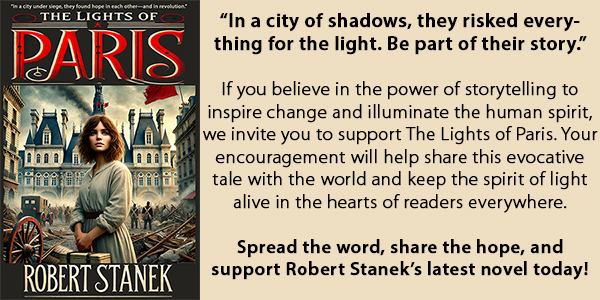
Support The Lights of Paris by Robert Stanek, William Stanek's pen name! Through vivid historical detail and deeply moving character stories, Robert takes readers on an unforgettable journey through one of history’s most transformative times.

